
Note: this was written and originally posted in 2004. The "seven years ago" mentioned is 1997.
The following events happened seven years ago. In all likelihood I've misremembered some things. I'm sure there are outright errors present. Please take it as one person's general perceptions of a the events and not as a documentary.
I'm not sure exactly when I started gaming. I know is that it was some time in the 80s. Based on some old gaming magazines I have sitting around I started gaming in 1986 at the latest. Like most gamers my first and longest experiences have been with Dungeons & Dragons. Some reports suggest that by the mid-80s TSR, the creators of D&D, were having problems, but to a young fan they could do no wrong. New products and supplements continued to flow forth from TSR's offices in Lake Geneva, Wisconsin. Every gamer wanted to attend TSR's convention, Gen Con (The Geneva Convention. Gamers have a strange sense of humor.).
Things did eventually sour. For a variety of reasons TSR slowly fell apart. The products TSR released were increasingly low quality. Many products had clearly never been tested. It was clear that TSR was treating Gen Con as an expense to be minimized, not as an opportunity to show their best side and build enthusiasm. They released Spellfire, the single worst trading card game ever; it was poorly recycled art slapped onto a game with the complexity of War. The new-fangled internet had created a place for gamers to share ideas. TSR would have no part of it and sent lawyers to shut down fan sites. TSR was determined to lead the role-playing industry into the toilet. When young upstart companies like White Wolf finally appeared TSR was in no shape to compete.
By 1997 TSR had left a foul taste in my mouth. Still, I harbored a small fondness for my first role-playing game. We bemoaned the state of the company, but we still played Advanced Dungeons & Dragons.
Into this story comes Evermore Entertainment, a small Madison start up. They won the contract to create computer support tools for AD&D. It would include character creation tools, hyperlinked rules, a map maker, a short computer rendered fantasy movie, and more. The results was the AD&D CD-ROM Core Rules.
The Core Rules sold tolerably well and TSR liked the product, so Evermore was commissioned to create a sequel. All was well and initial work was begun.

Then TSR ran out of money.
The slow decline had finally done the company in. To even casual observers it was clear that TSR was doomed. TSR was deeply in debt and they had destroyed the loyalty of all but the most die-hard fans.
Some time around fall 1996 Evermore was told that the project was off. TSR didn't have the money to pay the advances. Evermore laid off some staff intended for the project and started looking for new projects.
Enter Peter Adkison and Wizards of the Coast (WotC), a hot young upstart flush with money from the surprise success Magic: The Gathering. In a surprising move (at least to us fan-boys), in spring of 1997 WotC purchased TSR, paying off all of the outstanding debts.
With the acquisition underway many previously shelved projects were revived. The Core Rules was back on.
Evermore needed to refill their ranks. Into this situation I enter the story.
Evermore had run an ad in the University of Wisconsin at Madison student newspapers. They were looking for game developers. I was about to graduate with a computer science degree and naive enough that the computer game industry sounded like my dream job. My resumes had been ignored by video game developers across the country, but here was a local game company looking for programmers. In went my resume and I was granted an interview.
The primary focus of the interview seemed to be on my experiences with AD&D. Had I played? For how long? Had I run games? Would I be willing to run a game of AD&D at the office? There was a brief interview with the lead programmer, we chatted briefly about the UW's CS department, but there wasn't much on the technical side. Not quite what I was expecting, and nothing like Microsoft's full day marathon of technical interviews. I suspect that my willingness to run a game got me the job. Perhaps that and my (in hindsight) ridiculously low desired salary. I suppose if the just-out-of-college kid is cheap enough, you can afford to take a risk. For that I'm extremely thankful.
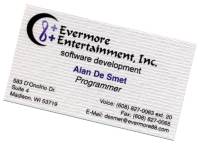
Anyway, when I started at Evermore, WotC was in the middle of acquiring TSR. The Core Rules 2.0 were back on, but the details weren't set. Some of the team would need to head down to Lake Geneva to meet with TSR and WotC people. So sometime during the first month of my career I visited TSR's headquarters.
I may have lost respect for the company, but this was still the birthplace of gaming; I was to be permitted into the inner sanctum. Three of us went down, my boss Victor Penman, my co-worker Jim Sehmer, and myself.
The outside of the building wasn't noteworthy, just a light brown warehouse sitting in a boring industrial park.
Passing through the building to our meetings we passed a few interesting sights, including a glass and mirror tunnel into the lunchroom and the arcade game Dungeons & Dragons: Shadow Over Mystara. Walking through I quickly noted how empty the place felt. The building had a great deal of office space and it had clearly at one point been used. But by spring of 1997 it was a ghost town. There were empty offices and cubicles wherever we went. Partially filled whiteboards and paperwork covered tables suggested that everyone had just stepped out briefly, but during my time there the place never filled.
The first part of the day was meetings. I don't remember much about most of the meetings. I do distinctly remember speaking with some of AD&D's designers. They were talking about the next edition of AD&D. The designers were working to reorganize the game, to minimize the number of special cases, and generally make it easier for both people and computers. I can only presume that this work eventually turned into the Third Edition of D&D (now widely known as 3e).
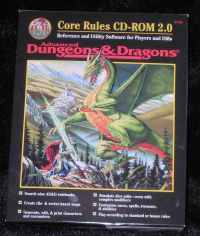
(A shameless bit of schadenfreude: A goal for 3e was to ship high quality computer tools, like the Core Rules, at the same time that 3e shipped. Evermore bid on the contract to develop the product, but lost the deal. The request for proposals called for for amazingly brief development period (less than a year) for a new product with many new features. My boss looked at the RFP and told them they could have a fraction of the functionality and it would cost a bundle. He wasn't being greedy, just realistic. Another company produced an unrealistically low bid and promised the world. Naturally, the other company won the contract. The contract called for a complete character generator to ship with the 3e Player's Handbook and the full product to ship soon thereafter. What shipped with the Player's Handbook was a barely functional demo that was a painful to use. The full product never shipped. Things went so badly that Wizards eventually handed the product off to loosely organized collective largely responsible for the completely free competing product, PCGen. My boss was right all along. Anyway, back to Lake Geneva.)
The last meeting of the morning was with WotC's head cheese Peter Adkison. I didn't know much about him, but I was liked what I knew. While TSR had been shutting down fan sites and otherwise pretending the internet didn't exist, Peter was online talking with fans, and he gave Janitor and CEO as his job title.
So we met Peter. I find it easy to picture Peter, but he's hard to describe. Peter is shorter than me, but lots of people are. At the time he was erring toward gamer Extra Large and had a round face to go with it. Peter had dark hair, cut in a tight buzz. He had a closely trimmed goatee. Between the roundness of his face and his receding hair line, the buzz failed to be menacing or serious in any way. His entire air was one of being decidedly amused with how things had turned out. I got a distinct sense that he got up every morning and said to himself, "Hey, I'm the head of one of the most successful gaming companies. How cool is that?"
We talked about the product. The Core Rules excited Peter. He loved the previous product, he loved the new ideas. Peter didn't love it from a business stand point; this was a man who wanted to use it himself.
Now, the previous Core Rules was very strict. If the game technically didn't allow something, neither did the program. Characters stopped progressing at level 20. Certain classes were strictly limited to certain fantasy races. For example, dwarves could not be paladins. Simply didn't happen. There were rules, and by God you followed them. This reinforced what I had gathered about TSR. Management didn't realize that every single gaming group modifies at least one rule. D&D wasn't TSR's game, it was everyone's game. TSR management wasn't gamers, they didn't understand this. Their thinking was "How could you violate The Rules?" So their software didn't understand it either.
Peter was aware of this. And it troubled him. You see, he had a 50th level dwarven paladin, and the program didn't support him. He wanted to make sure Core Rules 2 would support his dwarf. As he told us this, I became extremely happy that TSR's legacy was in this man's hands. He was a gamer, and not just a casual gamer. This was a man who wallowed in his geekhood with the rest of us.
As a small tribute to Peter, Jim made a dwarven paladin the default for the random NPC generator in Core Rules 2.0's random NPC generator (Upon reinstalling the software for the first time in years, this appears to be one of many things I misremembered. I'm almost certain that somewhere in the program it defaults to a dwarven paladin. It's possible it was removed before shipping, or is buried somewhere deeper.)
After the meeting it was time for lunch with Peter and a few other people. We were going to a local burger place. I don't entirely remember the circumstances, but Jim and I ended up getting a ride with Peter. I got shotgun. Peter had rented a pretty sporty car. I then discovered why Peter had such a sporty little car; Peter liked to go fast. In the process of getting from one side of TSR's parking lot to the other, Peter managed to get the car up to 55 miles per hour. He slowed down quickly, pulled out of the lot, then proceeded to race through Lake Geneva. I don't remember quite how fast we went, but I know that we beat everyone else to the restaurant by several minutes, impressive given that the place was just a few minutes away.
The restaurant itself was a lake-front burger joint, about as high class as a burger joint can get. The food was typical good burger joint food. More memorable than the food was watching Peter eat his burger. Like many burger joints there was a glass bottle of ketchup at each table. The bottle at our table was full when we arrived. Some was used as people glopped it onto plates for fries or onto their burger. When everyone had some Peter took the still mostly-full bottle. Bottle in his right hand, burger in his left, he proceeded to eat his burger. Before each bite he would dollop a healthy dab of ketchup on the burger, filling in the gap left by the previous bite. Peter was eating as much ketchup as burger. Being a nice burger joint, the burger was large. By the end of the meal the mostly-full bottle became mostly empty.
After lunch, back to TSR. There was a bit more meeting with Peter, perhaps one or two more meetings after that. Then the fun part, a tour of building. We were shown around by a nice woman whose name I don't remember. My boss remained behind, probably to talk business, while Jim and I went on tour.
First, the president's office. The room was large and spartan. An absolutely monstrous, hardwood desk dominated the center of the room. It was everything that a powerful CEO or evil mastermind could want from a desk; it owned the room. There was a suitably nice, high-backed leather chair behind the desk, but the desk was the center of attention. The desk had last belonged to TSR's previous owner, Lorraine Williams. Through some strange dealings in the 80s the company had ended up in the hands of Ms Williams, a woman who, by many reports, hated role-playing and held her customers in contempt. (Backup link.)
Attached to the office was a sauna that I didn't see. It had been Gary Gygax's. Someone, I believe at TSR, confided in me that he had heard from a friend of a friend that Back In The Day Gary had two female bodyguards, both armed with submachine guns. They apparently joined him in the sauna and there was an insinuation that the pair provided other services in the sauna. Years later a friend of mine asked Gary point blank about the rumor. Gary confirmed that he did have a bodyguard for a period when his life was threatened. Unfortunately for the story, the bodyguard was singular, male, didn't carry a submachine gun, and only provided bodyguard services.
Outside of the office a display case held a bunch of Buck Rogers memorabilia. Ms Williams had inherited the rights to Buck Rogers from her grandfather. This led to a TSR produced role-playing game that tanked and a board game that I'm rather fond of.
We were shown much of the rest of the building. Here and there were people working on some project, but lots of empty space. Again, the feeling of an abandoned property pervaded the place. However, among those that had survived the many layoffs there was a certain level of hope. I don't remember any specific statements, but it was clear to me at the time that everyone was happy that Ms Williams was gone. It was a distinct "Dong Dong the Witch is Dead" feeling, only without all the singing. Or the munchkins. At the time I really didn't know anything about the woman, but the impression I got during that visit was that she was not a good human being.
We met two of the artists currently on the staff. First we met Jeff Easley. Easley had painted many of the memorable TSR product covers. (Backup link.) His studio was well lit and mostly white. While it was clearly a working room, it was clean. A partially completed painting stood on an easel. Easley himself was nice enough, given these random visitors. I remember him looking like the room: an average build. Whatever he was wearing wasn't particularly memorable.
I remember even less of the second artist we met. The second artist's studio was in the back of the warehouse. I suspect it had been converted from the warehouse manager's office. I don't remember his name, but I remember a strong skull motif in his studio. I recall his wearing a black t-shirt and dark pants.
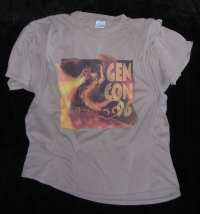
Finally, the highlight of the journey: The Mail Order Hobby Shop. For years TSR had run a mail order gaming store on the side. It had been shut down some time before, but the small storage room it worked out of survived. Back stock mingled with other leftovers. As our guest escorted us in, the first thing she did was press a light brown Gen Con 96 t-shirt into our hands. Apparently they had a back stock to get rid of. I had never purchased a convention t-shirt in all of my years of attending, and I haven't since, but I recognized my first professional swag. Years later it's still in exceptional shape. The shirt has a large, full color silk-screen on it, but while it has faded it hasn't cracked. I still wear it on occasion.
At that point Jim and I were given plastic bags and told to take what we wanted. I had free reign in TSR's dumping grounds. My new job rocked.
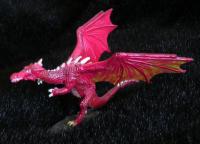
I filled my bag full of stuff. Oddly, I remember very little of what I got. There wasn't much in the way of role-playing games, but there were a lot of miniatures. I did score a nice Ral Partha dragon. I also got a few sets of very, very old TSR miniatures. They're nice miniatures, but most modern plastic miniatures have more detail.
On a lark I picked up Dennis Mize's Slave Auction. My friend Jeff and I had been painting miniatures and slowly working on improving our painting of flesh. The basically naked slaves seemed like a good opportunity to practice. Really, I'm serious. So I grabbed the Slave Auction pack for my friend. Jeff was amused by the set. In hindsight, I gave away the pick of the litter. Jeff later asked about the set at Ral Partha booth. The "Limited Edition" label at the top was serious; it was a 5,000 set run. It was already valuable when I had given it to Jeff.
While I had gotten some neat stuff, my expectations had been slightly higher. In particular, I was interested in the relatively new Saga rules system (original link) in the new Dragonlance: Fifth Age (original link) game. I asked our guide about it, and almost immediately realized that I was being a selfish prick. Our guide apologized that they had almost nothing new in the shop.
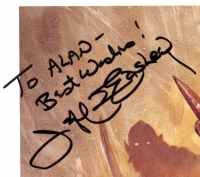
Somewhere in there I was also given a copy of The Worlds of TSR, an TSR art book. On our way our we swung by Easley's office again and he graciously signed one of his pieces in it. At the time I didn't really appreciate it, neither the book nor the signature. Looking back, it's one of the coolest things I received (besides amusing stories about Peter Adkison that is). Flipping through it, TSR may have been rotten at the core, but they produced beautiful art. The piece he signed (backup link), skeletons moving through a grey wood, is a cool.
Finally we headed out. My boss finished whatever meetings he needed and we headed out to the car. As we were getting into the car, our tour guide came racing out. In her hand was Dragonlance: Fifth Age and the first supplement. She had scored me a copy. At this point I feel quite terrible for forgetting her name, she was way beyond the call of duty.
With that we drove back to Madison.
I've had several jobs since then. I've worked for a dot com startup, a genetic sequencing software company, and university research project. I've been across the United States on business trips. Occasionally I've been lucky enough to see some cool things on those trips. I've even been out to Edinburgh, Scotland to give a tutorial. All have been fun in their own way, but I don't think anything will ever quite match my first business trip.
Got comments on this? Post `em here.
2006-12-06: In 1997 Ryan Dancey evaluated TSR for Wizards of the Coast to see if it could be saved. Dancey's analysis of why TSR failed is quite interesting.
2014-05-09: Added note to top clarifying when this was written. Also, a few typo fixes, and deleted a link that had been taken over by a porn site.